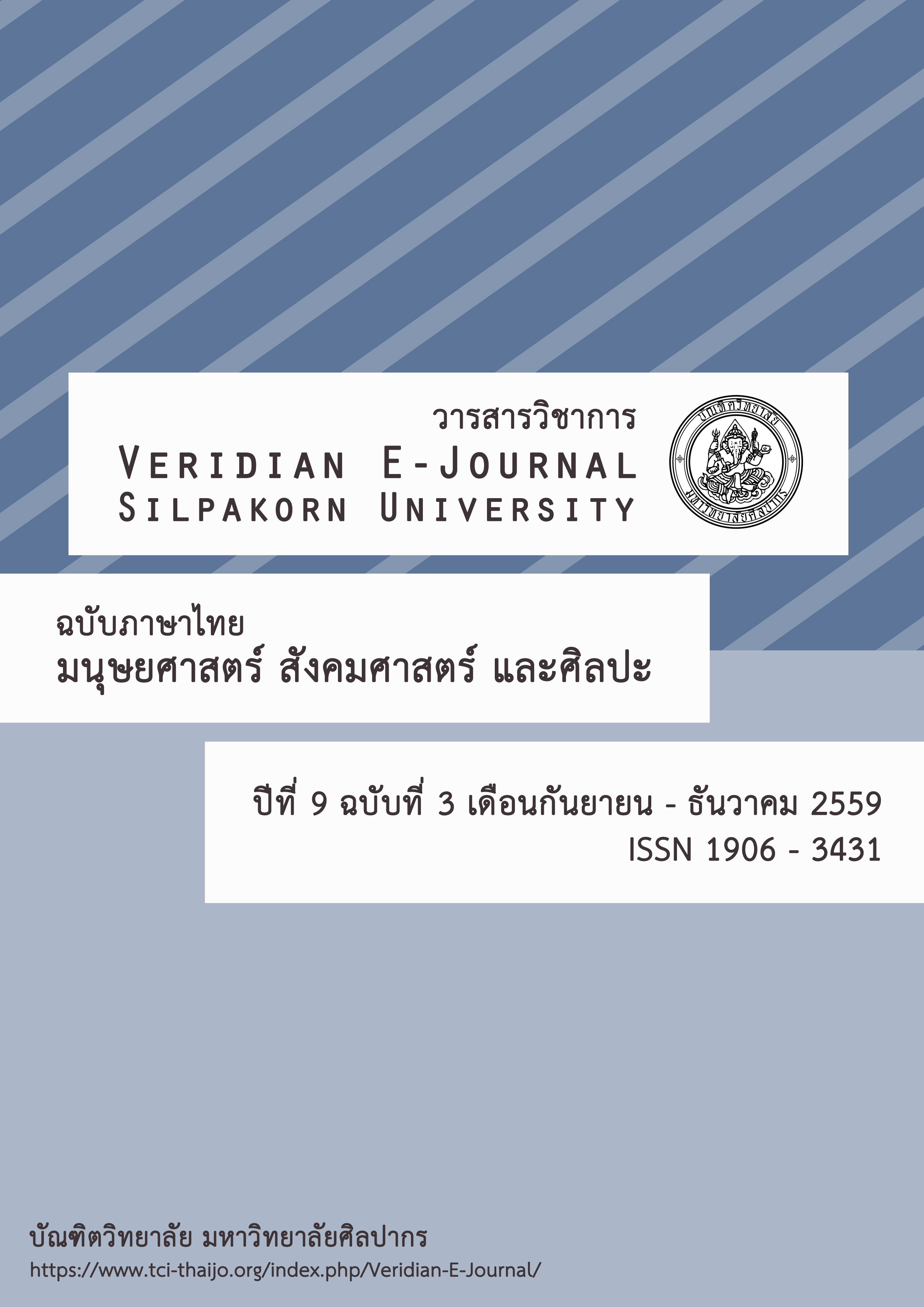แนวทางในการสร้างพันธมิตรทางธุรกิจภายใต้บริบทประชาคมเศรษฐกิจอาเซียน สำหรับธุรกิจสปาและนวดไทย
Main Article Content
บทคัดย่อ
การวิจัยครั้งนี้มีวัตถุประสงค์เพื่อ 1) ศึกษาแนวทางการสร้างพันธมิตรทางธุรกิจของธุรกิจ สปาและนวดไทย 2) ศึกษาองค์ประกอบของการสร้างพันธมิตรทางธุรกิจ กระบวนการเรียนรู้จากพันธมิตรทางธุรกิจ และ ประสิทธิภาพการดำเนินงานด้านพันธมิตรของธุรกิจสปาและนวดไทย 3) ศึกษาความสัมพันธ์เชิงสาเหตุองค์ประกอบของการสร้างพันธมิตรทางธุรกิจ กระบวนการเรียนรู้จากพันธมิตรทางธุรกิจ ที่มีอิทธิพลต่อประสิทธิภาพการดำเนินงานด้านพันธมิตรของธุรกิจสปาและนวดไทย การวิจัยครั้งนี้ ใช้กระบวนการวิจัยและระเบียบวิธีวิจัยตั้งอยู่บนรากฐานการวิจัยเชิงปริมาณและการวิจัยเชิงคุณภาพ ในการวิจัยเชิงคุณภาพ ใช้วิธีการสัมภาษณ์เชิงลึกกับผู้ประกอบการหรือผู้บริหารที่มีส่วนเกี่ยวข้องกับการจัดการพันธมิตรของธุรกิจสปาและนวดไทย จำนวน 10 ท่าน สำหรับการวิจัยเชิงปริมาณ ใช้แบบสอบถามในการเก็บรวบรวบรวมข้อมูลจากผู้ประกอบการหรือผู้บริหารที่มีส่วนเกี่ยวข้องกับการจัดการพันธมิตรของธุรกิจสปาและนวดไทย จำนวน 306 แห่ง การวิเคราะห์ข้อมูลเชิงคุณภาพใช้การวิเคราะห์เนื้อหา ส่วนสถิติที่ใช้การวิเคราะห์ข้อมูลเชิงปริมาณ คือ จำนวน ร้อยละ ค่าเฉลี่ย ส่วนเบี่ยงเบนมาตรฐาน และ การวิเคราะห์ตัวแบบสมการโครงสร้าง
ผลการวิจัยสรุปได้ดังนี้
1. ผลการศึกษาพบว่า แนวทางการสร้างพันธมิตรทางธุรกิจของธุรกิจสปาและนวดไทย มีการจัดหาและเริ่มต้นติดต่อคู่พันธมิตรจากคู่ค้าของธุรกิจเดิมที่มีอยู่ คุณลักษณะสำคัญของคู่พันธมิตรทางธุรกิจ สรุปได้ว่า ธุรกิจสปาและนวดไทยจะพิจารณาจากชื่อเสียงของธุรกิจ และความน่าเชื่อถือไว้วางใจได้ของธุรกิจ ในการทำความร่วมมือเป็นพันธมิตรทางธุรกิจ จะมีการดำเนินการ 2 แบบ คือ แบบไม่เป็นทาง และแบบเป็นทางการ สำหรับเหตุผลในการเข้าร่วมเป็นพันธมิตรทางธุรกิจนั้น มีเป้าหมายหลัก เพื่อเป็นการขยายตลาดหรือกลุ่มลูกค้าให้มากขึ้น รองลงมา คือ เป็นการยกระดับการให้บริการของธุรกิจ และทำให้ได้วัตถุดิบหรือผลิตภัณฑ์ที่ใช้ในการให้บริการของธุรกิจ ที่ตรงกับคุณภาพและมาตรฐานตามที่ธุรกิจต้องการ
2. ผลการศึกษาองค์ประกอบของการสร้างพันธมิตรทางธุรกิจ กระบวนการเรียนรู้จากพันธมิตรทางธุรกิจ และ ประสิทธิภาพการดำเนินงานด้านพันธมิตรของธุรกิจสปาและนวดไทย พบว่า ภาพรวมขององค์ประกอบของการสร้างพันธมิตรของธุรกิจสปาและนวดไทย ทั้ง 5 องค์ประกอบ คือ ความผูกพัน หน้าที่ ด้านพันธมิตร ความร่วมมือ และความไว้วางใจ มีค่าเฉลี่ยอยู่ในระดับมาก แต่การมีประสบการณ์ด้านพันธมิตร มีค่าเฉลี่ยอยู่ในระดับต่ำ ในส่วนของภาพรวมของกระบวนการเรียนรู้จากพันธมิตรทางธุรกิจทั้ง 4 ด้าน พบว่า ด้านการประมวลความรู้ ด้านกระบวนการแลกเปลี่ยนเรียนรู้ ด้านการแบ่งปันความรู้ และด้านการกำหนดความรู้ที่ชัดเจน (Knowledge articulation) มีค่าเฉลี่ยอยู่ในระดับมากทุกด้าน สำหรับ ประสิทธิภาพการดำเนินงานด้านพันธมิตรของธุรกิจสปาและนวดไทย มีค่าเฉลี่ยในภาพรวมอยู่ในระดับมาก เช่นกัน3. ผลการศึกษาความสัมพันธ์เชิงสาเหตุองค์ประกอบของการสร้างพันธมิตรทางธุรกิจ กระบวนการเรียนรู้จากพันธมิตรทางธุรกิจ ที่มีอิทธิพลต่อประสิทธิภาพการดำเนินงานด้านพันธมิตรของธุรกิจสปาและนวดไทย พบว่า ภาพรวมขององค์ประกอบของการสร้างพันธมิตรที่มีอิทธิพลทั้งทางตรงและทางอ้อม โดยกระทำผ่านกระบวนการเรียนรู้จากพันธมิตรทางธุรกิจไปยังประสิทธิภาพการดำเนินงานด้านพันธมิตร คือ ความผูกพัน (TE= 0.29) รองลงมา คือ ความไว้วางใจ (TE= 0.26) หน้าที่ด้านพันธมิตร (TE= 0.22) และประสบการณ์ด้านพันธมิตร (TE= 0.08) อย่างมีนัยสำคัญทางสถิติ ยกเว้น องค์ประกอบของการสร้างพันธมิตรด้านความร่วมมือ ถึงแม้จะมีค่าอิทธิพลรวม เท่ากับ 0.09 แต่ไม่มีนัยสำคัญทางสถิติ โดยองค์ประกอบของการสร้างพันธมิตรซึ่งกระทำผ่านกระบวนการเรียนรู้จากพันธมิตรทางธุรกิจ สามารถอธิบายความสัมพันธ์ที่มีต่อประสิทธิภาพการดำเนินงานด้านพันธมิตรได้ร้อยละ 65.80 (R2= 0.658)
The purposes of this research were 1) to study a guideline to build business alliance for Thai Spa and Massage, 2) to study elements of building business alliance, alliance learning process and alliance performance of Thai Spa and Massage, and 3) to study causal relationship of elements of building business alliance and alliance learning process which influence alliance performance of Thai Spa and Massage. This research based its process and methodology on quantitative and qualitative research methods. On qualitative method, the researcher used an in-depth interview with 10 entrepreneurs or managers who involved in alliance management of Thai Spa and Massage. As for quantitative method, the researcher used a questionnaire to collect data from 306 entrepreneurs or managers who involved in alliance management of Thai Spa and Massage. The researcher used the content analysis to analyze the qualitative data. As for statistics used in the quantitative data analysis, the researcher used frequency, percentage, mean, standard deviation and Structural Equation Modeling (SEM).
The results of this research were as following.
1) Guideline to building business alliance for Thai Spa and Massage, it was found that the business was obtained and contacted with alliances through existing suppliers. The important criteria of business alliance partner were that Thai Spa and Massage would mainly consider a reputation and reliability of the partner’s business. On collaboration of business alliance, there were 2 types; informal and formal. The main reason of participating in business alliance was to expand the market or to increase numbers of customer. Secondly, it was to improve the level of business service that would meet the required quality and standard.
2) When studying elements of building business alliance, alliance learning process and alliance performance of Thai Spa and Massage, it was found that five factors of building business alliance which were commitment; alliance function; cooperation; and trust were overall at high level, while the alliance experience was the only factor found at low level. On alliance learning process, there were 4 aspects which were knowledge codification, knowledge internationalization, knowledge sharing and knowledge articulation, it was overall found at high level on all 4 aspects. As for alliance performance of Thai Spa and Massage, it was overall found at high level too.
3) The result of studying a causal relationship of elements of building business alliance and alliance learning process which influence alliance performance of Thai Spa and Massage, it was found that the elements of building business alliance had direct and indirect influences through alliance learning process, such elements were commitment (TE= 0.29), trust (TE= 0.26), alliance function (TE= 0.22) and alliance experiences (TE= 0.08) respectively. All above factors showed statistical significant level except the factor of alliance cooperation. Though the alliance cooperation received TE at 0.09, it was not found statistical significance. The elements of building business alliance through alliance learning process could explain the relation towards alliance management efficiency at 65.80 percent (R2= 0.658).

